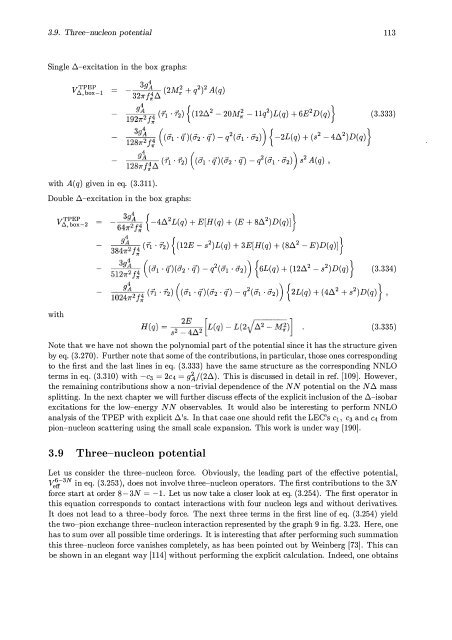The Nucleon-Nucleon Interaction in a Chiral Effective Field Theory
The Nucleon-Nucleon Interaction in a Chiral Effective Field Theory
The Nucleon-Nucleon Interaction in a Chiral Effective Field Theory
Create successful ePaper yourself
Turn your PDF publications into a flip-book with our unique Google optimized e-Paper software.
3.9. Three-nucleon potential<br />
S<strong>in</strong>gle ß-excitation <strong>in</strong> the box graphs:<br />
VTPEP A,box-1 =<br />
3g�<br />
(2M2 + q2)2 A(q)<br />
327f f: 7f ß<br />
19::2 f: (Ti · T2) {(12ß2 - 20M; - Ul)L(q) + 6E2 D(q)} (3.333)<br />
12��� f : ((51 . if)(52 . if) - q2(51 . (2)) { -2L(q) + (s2 -4ß2)D(q)}<br />
128��: (Tl · T2) ((51 . if)(52 · if) -q2(51 · 52)) s2 A(q) ,<br />
ß<br />
with A(q) given <strong>in</strong> eq. (3.311).<br />
Double ß-excitation <strong>in</strong> the box graphs:<br />
VTPEP A,box-2 = -6 :::f: { -4ß2 L(q) + E[H(q) + (E + 8ß2)D(q)]}<br />
with<br />
38 ::2 f: (Tl · T2) { (12E - s2)L(q) + 3E[H(q) + (8ß2 -E)D(q)]}<br />
51�� f: ((51 . if)(52 . if) - q2(51 . (2)) {6L(q) + (12ß 2 - s2)D(q)} (3.334)<br />
102��2 f: (Tl · T2) ((51 . if)(52 · if) - q2(51 · 52)) {2L(q) + (4ß2 + s2)D(q)}<br />
113<br />
(3.335)<br />
Note that we have not shown the polynomial part of the potential s<strong>in</strong>ce it has the structure given<br />
by eq. (3.270). Further note that some of the contributions, <strong>in</strong> particular, those ones correspond<strong>in</strong>g<br />
to the first and the last l<strong>in</strong>es <strong>in</strong> eq. (3.333) have the same structure as the correspond<strong>in</strong>g NNLO<br />
terms <strong>in</strong> eq. (3.310) with -C3 = 2C4 = g�/(2ß). This is discussed <strong>in</strong> detail <strong>in</strong> ref. [109]. However,<br />
the rema<strong>in</strong><strong>in</strong>g contributions show a non-trivial dependence of the N N potential on the N ß mass<br />
splitt<strong>in</strong>g. In the next chapter we will furt her discuss effects of the explicit <strong>in</strong>clusion of the ß-isobar<br />
excitations for the low-energy N N observables. It would also be <strong>in</strong>terest<strong>in</strong>g to perform NNLO<br />
analysis of the TPEP with explicit ß's. In that case one should refit the LEC's Cl , C3 and C4 from<br />
pion-nucleon scatter<strong>in</strong>g us<strong>in</strong>g the small scale expansion. This work is under way [190].<br />
3.9 Three-nucleon potential<br />
Let us consider the three-nucleon force. Obviously, the lead<strong>in</strong>g part of the effective potential,<br />
Ve�-3N <strong>in</strong> eq. (3.253), does not <strong>in</strong>volve three-nucleon operators. <strong>The</strong> first contributions to the 3N<br />
force start at order 8-3N = -1. Let us now take a closer look at eq. (3.254). <strong>The</strong> first operator <strong>in</strong><br />
this equation corresponds to contact <strong>in</strong>teractions with four nucleon legs and without derivatives.<br />
It does not lead to a three-body force. <strong>The</strong> next three terms <strong>in</strong> the first l<strong>in</strong>e of eq. (3.254) yield<br />
the two-pion exchange three-nucleon <strong>in</strong>teraction represented by the graph 9 <strong>in</strong> fig. 3.23. Here, one<br />
has to sum over all possible time order<strong>in</strong>gs. It is <strong>in</strong>terest<strong>in</strong>g that after perform<strong>in</strong>g such summation<br />
this three-nucleon force vanishes completely, as has been po<strong>in</strong>ted out by We<strong>in</strong>berg [73]. This can<br />
be shown <strong>in</strong> an elegant way [114] without perform<strong>in</strong>g the explicit calculation. Indeed, one obta<strong>in</strong>s












